Lilies typically take about two to four weeks to bloom after the planting season, depending on the variety and growing conditions. Most lilies bloom during the summer months, showcasing their beautiful flowers for several weeks.
Lilies are among the most beloved flowering plants in gardens around the world. With their stunning colors and enchanting fragrance, they have become a favorite for both novice and experienced gardeners. Understanding how long it takes for lilies to bloom is essential for those looking to cultivate these beautiful flowers. This knowledge helps in planning garden layouts and ensuring that the flowering season aligns with other garden activities.

There are several factors that influence the blooming time of lilies. These include the type of lily, climate conditions, and care practices. Different varieties of lilies will have unique growth patterns and blooming schedules. Here are a few key points to keep in mind:
| Lily Variety | Typical Bloom Time | Height |
|---|---|---|
| Asiatic Lilies | Mid to Late Summer | 2-4 feet |
| Oriental Lilies | Late Summer to Early Fall | 3-5 feet |
| Trumpet Lilies | Mid to Late Summer | 3-6 feet |
| OT (Orienpet) Lilies | Mid to Late Summer | 3-5 feet |
Factors Affecting Bloom Time
The bloom time of lilies can be affected by multiple factors. Each factor plays a significant role in determining when these flowers will show their vibrant colors. Below are some of the major factors to consider:
1. Lily Variety
The specific type of lily significantly influences how long it takes to bloom. For example, Asiatic lilies tend to bloom earlier in the summer, whereas Oriental lilies will bloom later in the season. Knowing the variety you are planting can help you anticipate when they will bloom.

2. Climate Conditions
Climate plays a crucial role in the blooming process. Lilies thrive in well-drained soil with plenty of sunlight. In regions with cooler temperatures, lilies may take longer to bloom. Conversely, warmer climates can accelerate their growth. Gardeners in different areas may see varying results due to these climatic differences.
3. Soil Quality
The quality of the soil is another critical factor. Rich, well-draining soil provides the nutrients necessary for healthy growth. If the soil lacks essential nutrients or retains too much moisture, it can delay blooming times. Regularly checking soil conditions and amending it as necessary can promote quicker blooming.
4. Watering Practices
Watering practices also impact how quickly lilies will bloom. Overwatering can lead to bulb rot, while underwatering can cause stress to the plant. Striking a balance is essential for healthy growth and timely blooming. A consistent watering schedule that allows the soil to dry slightly between waterings is ideal.

5. Fertilization
Fertilizing lilies at the right time can enhance their blooming potential. A balanced fertilizer applied in early spring can give them a strong start. However, it is essential not to over-fertilize, as this can lead to excessive foliage at the expense of blooms.
Understanding these factors allows gardeners to create optimal conditions for their lilies. With proper care and attention, it is possible to enjoy breathtaking blooms throughout the summer months.
Preparing for Planting Lilies
To ensure that lilies bloom beautifully, proper preparation is essential. This involves selecting the right bulbs, choosing the right time for planting, and preparing the soil effectively. By taking these steps, gardeners can significantly enhance the chances of successful blooming.

Selecting the Right Bulbs
The first step in planting lilies is choosing high-quality bulbs. When selecting bulbs, consider the following:
- Size: Larger bulbs generally produce stronger plants with more flowers. Look for bulbs that are at least 2 to 3 inches in diameter.
- Health: Choose bulbs that are firm and free of mold or soft spots. Healthy bulbs will establish roots more quickly.
- Variety: Select varieties that are suitable for your climate and that will bloom at the desired time.
Timing for Planting
The timing of planting plays a crucial role in blooming success. Lilies can be planted in both spring and fall, but the timing will affect their growth cycle:
- Spring Planting: If planting in spring, aim for early to mid-April. This allows the bulbs to establish roots before the warmer weather arrives.
- Fall Planting: Fall planting is typically done in September or October. This gives the bulbs a chance to root before winter sets in, leading to earlier blooms in summer.
Soil Preparation
Preparing the soil is vital for healthy lily growth. Here are steps to ensure optimal soil conditions:
- Testing Soil pH: Lilies prefer a slightly acidic to neutral pH (around 6.0 to 7.0). Testing kits are available at garden centers.
- Amending Soil: If necessary, amend the soil with organic matter such as compost or well-rotted manure to improve drainage and nutrient content.
- Drainage: Ensure proper drainage by amending heavy clay soils with sand or perlite. Good drainage prevents bulb rot.
Caring for Lilies After Planting
Once the lilies are planted, ongoing care is crucial for promoting healthy growth and vibrant blooms. This includes watering, mulching, and monitoring for pests and diseases.
Watering Techniques
Watering is an essential aspect of lily care. Here are some tips to keep in mind:
- Consistency: Water lilies consistently, especially during dry spells. Aim for about an inch of water per week.
- Avoid Overhead Watering: Water at the base of the plants to keep foliage dry, reducing the risk of fungal diseases.
- Moisture Check: Check the soil moisture before watering. The top inch of soil should dry out between waterings.
Mulching
Applying mulch can be beneficial for lilies. Here’s how it helps:
- Temperature Regulation: Mulch helps regulate soil temperature, keeping it cooler in hot weather and warmer in cold seasons.
- Weed Suppression: A layer of mulch can prevent weeds from competing with lilies for nutrients and water.
- Moisture Retention: Mulch retains soil moisture, reducing the frequency of watering required.
Pest and Disease Management
Lilies can be susceptible to various pests and diseases. Being vigilant and proactive can help manage these issues effectively:
- Pests: Watch for aphids, spider mites, and lily beetles. Manual removal or insecticidal soap can help control these pests.
- Diseases: Fungal diseases like botrytis can affect lilies. Ensure good air circulation and avoid overhead watering to minimize risks.
- Regular Inspection: Regularly inspect plants for signs of distress or damage. Early detection is key to effective treatment.
Caring for lilies involves understanding their needs throughout their growth cycle. By preparing adequately and maintaining proper care practices, gardeners can look forward to a spectacular display of blooms during the summer months.
Common Lily Varieties and Their Bloom Times
Understanding the different varieties of lilies can help gardeners choose the best options for their gardens. Each variety has unique characteristics, including bloom times, colors, and heights. Here, we will explore some popular lily varieties and their specific blooming periods.
Asiatic Lilies
Asiatic lilies are one of the earliest blooming varieties. They are known for their vibrant colors and strong stems.
- Bloom Time: Mid to late summer.
- Colors: Available in shades of yellow, orange, red, and pink.
- Height: Typically grow between 2 to 4 feet tall.
Oriental Lilies
Oriental lilies are celebrated for their exquisite fragrance and large flowers.
- Bloom Time: Late summer to early fall.
- Colors: Commonly found in white, pink, and purple hues.
- Height: Can reach heights of 3 to 5 feet.
Trumpet Lilies
Trumpet lilies are distinguished by their long, trumpet-shaped flowers. They provide a stunning display in any garden.
- Bloom Time: Mid to late summer.
- Colors: Typically available in white, yellow, and orange.
- Height: Can grow between 3 to 6 feet tall.
OT (Orienpet) Lilies
OT lilies are hybrids that combine the best features of Oriental and Trumpet lilies. They are known for their size and fragrance.
- Bloom Time: Mid to late summer.
- Colors: Often found in shades of pink, white, and yellow.
- Height: Generally grow 3 to 5 feet tall.
Environmental Factors Impacting Blooming
The environment where lilies are planted can greatly influence their growth and blooming time. Several key factors must be considered to ensure optimal blooming conditions.
Sunlight Requirements
Lilies thrive in full sunlight but can also tolerate partial shade. The amount of sunlight they receive directly affects their blooming time and flower quality.
- Full Sun: Ideal for most varieties; provides at least 6 hours of direct sunlight daily.
- Partial Shade: Some varieties can tolerate shade but may bloom later and produce fewer flowers.
Temperature Considerations
The temperature plays a vital role in the growth cycle of lilies. Understanding the temperature range suitable for different varieties helps in planning their placement in the garden.
- Cool Temperatures: Many lilies prefer cooler temperatures during their initial growth phase.
- Warm Weather: As temperatures rise in late spring and summer, lilies will begin to bloom more rapidly.
Humidity Levels
The humidity in the environment can also affect lily growth. While lilies appreciate moisture, excessive humidity can lead to fungal diseases.
- Adequate Humidity: A moderate level helps keep plants hydrated without causing disease.
- Avoiding Overly Humid Conditions: Ensure good air circulation around plants to minimize disease risk.
Caring for Blooms After They Appear
Once lilies have bloomed, proper care is essential for prolonging their beauty and health. This involves deadheading, watering, and fertilizing practices.
Deadheading
Deadheading is the practice of removing spent flowers. This encourages new growth and can enhance blooming in subsequent years.
- Timing: Deadhead as soon as flowers begin to wilt to redirect energy back into the plant.
- Method: Use clean scissors or shears to snip off the flower just above the first set of leaves.
Watering After Blooming
Proper watering after blooms appear is crucial for maintaining lily health. Here are some tips:
- Avoid Overwatering: Continue with a consistent watering schedule but reduce frequency as temperatures cool down in late summer.
- Mature Plants: Established plants may require less water than newly planted bulbs.
Fertilizing Post-Bloom
A balanced fertilizer can help support the plant after it has bloomed. This preparation is essential for next year’s growth.
- Type of Fertilizer: Use a low-nitrogen fertilizer to avoid excessive leaf growth at the expense of blooms.
- Timing: Fertilize in late summer after blooming has completed to strengthen the bulbs for winter dormancy.
An understanding of these aspects will significantly enhance the overall success of growing lilies in your garden. With careful planning and maintenance, these beautiful flowers can provide joy and color throughout the growing season.
In addition to the care tips mentioned earlier, it is essential to consider the long-term health of your lilies. Regular maintenance not only promotes blooming but also strengthens the bulbs for future growth. Here are some additional practices to incorporate into your lily care routine.
Dividing Bulbs
Over time, lily bulbs can become overcrowded, leading to reduced flowering. Dividing bulbs every few years helps maintain their vigor and encourages better blooms.
- When to Divide: The best time to divide lily bulbs is in the fall after blooming has finished or in the spring before new growth starts.
- How to Divide: Carefully lift the bulbs out of the ground with a spade, separate them gently, and replant them at the appropriate depth.
Winter Care
Preparing lilies for winter is crucial, especially in colder climates. Taking steps to protect the bulbs can lead to healthier plants in the spring.
- Mulching: Apply a thick layer of mulch over the bulb area to insulate against freezing temperatures.
- Removing Foliage: Once the foliage has died back, trim it down to ground level to prevent disease.
Choosing Companion Plants
Companion planting can enhance the beauty of your garden and provide benefits to your lilies. Some plants can deter pests or enhance soil quality.
- Avoid: Plants that compete for nutrients or have similar growth habits should be avoided near lilies.
- Good Companions: Consider planting lilies with other perennials like daylilies or ornamental grasses that complement their growing conditions.
Final Thoughts
The journey of growing lilies is as rewarding as it is beautiful. From selecting the right variety to understanding their growth needs, each step plays a crucial role in achieving a stunning display of blooms. It typically takes two to four weeks for lilies to bloom after planting, but this timeline can vary based on several factors, including the specific variety, soil conditions, and care practices.
By implementing proper planting techniques, providing adequate care, and being mindful of environmental factors, gardeners can ensure that their lilies thrive year after year. The satisfaction of witnessing these elegant flowers bloom makes all the effort worthwhile. With attention to detail and a bit of patience, you will enjoy vibrant colors and delightful fragrances throughout the summer months.
Ultimately, whether you are an experienced gardener or just starting out, growing lilies offers an opportunity to connect with nature and beautify your surroundings. Plan ahead and embrace the joys of gardening to create a thriving lily display that brings joy and admiration from all who see it.
